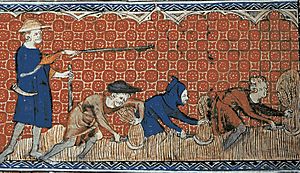Socage facts for kids

British Library, London.
Socage was a special way people in England used to hold land during the feudal system. Imagine it like a deal: farmers got to use land, and in return, they made regular, fixed payments to their feudal lords. These payments were usually money, but sometimes they could be goods.
In this deal, the lord had to protect the farmer. The lord also had duties to the King or Queen (the Crown). Over time, socage changed. It became a type of land ownership called "free and common socage." This new form didn't involve the old feudal duties anymore.
Socage was different from other ways of holding land back then. For example, it wasn't like knight-service, where you had to fight for your lord. It also wasn't like frankalmoin, which was for religious service.
How Socage Changed Over Time
In 1290, King Edward I made a law called Quia Emptores. This law helped make socage tenure more stable. It meant that when land held by socage passed from one person to the next, it was clear how it would happen. There might be a small tax, but the land stayed with the family or chosen person. This was different from a simple lease, which could be taken away or have its rent increased easily.
As the feudal system slowly ended, socage became more and more common. Eventually, it was the main way people owned land in England. In 1660, a very important law called the Statute of Tenures was passed. This law officially ended the old system where land owners had to provide military or religious service. Most land ownership types, including freehold, were then changed into "free and common socage."
Who Were the Socagers?
A person who held land through socage was called a socager. Sometimes, they were also called a socman. The word socage comes from an old Latin word that means "plough." This suggests that socage was often connected to farming and working the land.
See also
- Soke (legal)
- Quia Emptores
- Statute of Tenures
- History of English land law

